If you’re looking for a versatile and delicious fish to add to your meals, halibut is an excellent choice. With its mild flavor and firm texture, it pairs well with a variety of ingredients and cooking methods.
Whether you’re an experienced chef or just starting out in the kitchen, these 10 halibut recipes will inspire you to create mouthwatering dishes. From baking to grilling, you’ll find easy-to-follow recipes that can turn a simple halibut fillet into a gourmet meal. Enjoy the exploration of flavors and find new favorites for your dinner table.
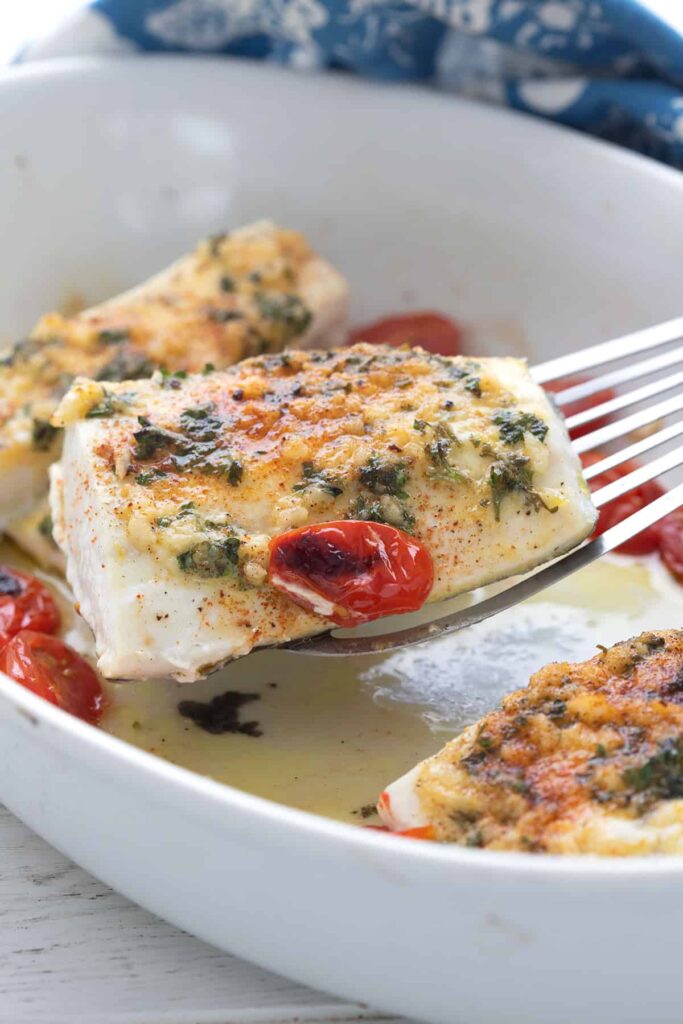
1) Lemon Garlic Halibut
Lemon Garlic Halibut is a flavorful and easy-to-make dish. Start by patting the halibut fillets dry. This ensures that the seasoning will stick properly. Season the fillets with salt, pepper, and garlic powder.
Melt some butter and mix it with minced garlic, parsley, and chives. This will form a tasty butter mixture. Pour half of this mixture over the fillets.
Place the fillets in a greased baking dish. Put one lemon slice on top of each fillet. This adds a fresh citrus flavor. Bake at 350℉ for around 12-16 minutes until the fish is cooked through.
If you prefer, you can marinate the halibut in the lemon garlic mixture for more flavor. Just cover the dish with plastic wrap and let it sit in the fridge for about 30 minutes to 2 hours. Then bake as usual.
For a quick variation, sprinkle the fillets with Italian seasoning and a pinch of red pepper flakes before baking. These spices add a nice kick.
Once the halibut is cooked, garnish with chopped parsley or a squeeze of fresh lemon juice. Serve it hot for a delicious meal.
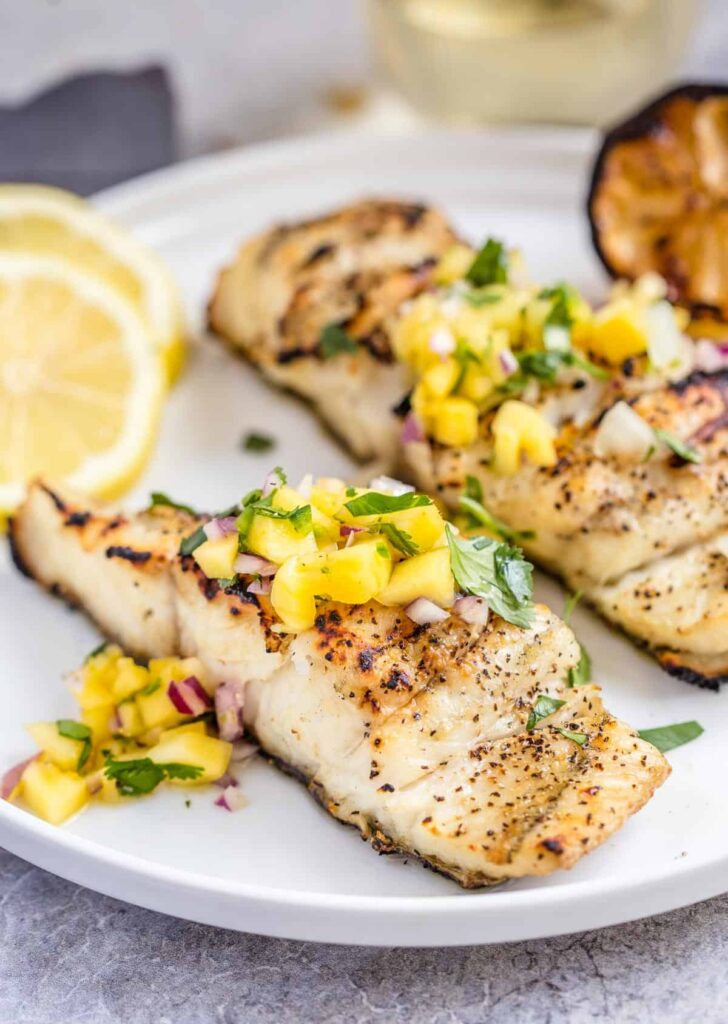
2) Grilled Halibut with Mango Salsa
Grilled halibut with mango salsa is a perfect blend of savory and sweet. The rich, meaty texture of halibut pairs well with the fresh, tangy flavors of mango salsa.
Start by preparing your grill to medium heat. Season the halibut fillets with salt and pepper. Toss the fish in a bit of olive oil to keep it moist while grilling.
Place the halibut fillets directly on the grill. Cook for about four to five minutes per side, depending on the thickness. The halibut should flake easily with a fork when done.
While the fish is grilling, prepare the mango salsa. Combine diced mango, bell pepper, red onion, and cilantro in a bowl. Add a squeeze of fresh lime juice and a pinch of salt to bring out the flavors.
Let the mango salsa sit for a few minutes to allow the ingredients to meld. This will enhance the taste.
Serve the grilled halibut topped with the mango salsa. The sweetness of the mango contrasts beautifully with the savory grilled fish. This dish is perfect for a summer barbecue or a light dinner. It’s both healthy and delicious.
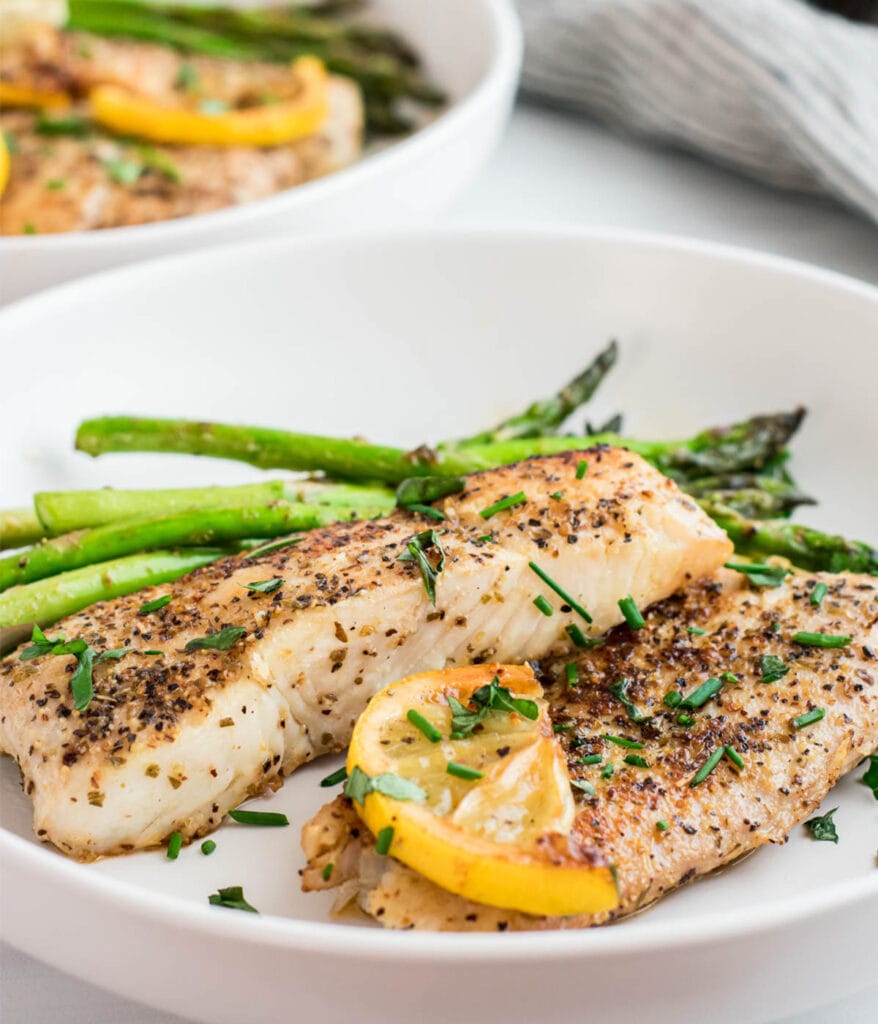
3) Pan-Seared Halibut with Herb Butter
Pan-seared halibut with herb butter is a delightful dish. Start by patting your halibut fillets dry with a paper towel. Season the fish with salt, pepper, garlic powder, and your favorite herbs, such as parsley or oregano.
Heat olive oil in a large skillet over medium-high heat. Once the oil is hot, add the halibut fillets. Cook the fish skin-side up without moving it until the bottom is golden and crispy. This usually takes about 3-4 minutes.
Carefully flip the fillets and cook the other side for another 2-4 minutes until they are fully cooked. You will know they are done when the fish easily flakes with a fork.
While the fish is cooking, prepare your herb butter. In a small saucepan, combine softened butter, minced garlic, chopped herbs, and lemon zest. Stir until everything is well mixed and the butter is melted.
Once your halibut is ready, spoon the herb butter over the top of the fillets. Allow the butter to melt and infuse the fish with its rich flavors. Serve hot and enjoy your delicious pan-seared halibut with herb butter.
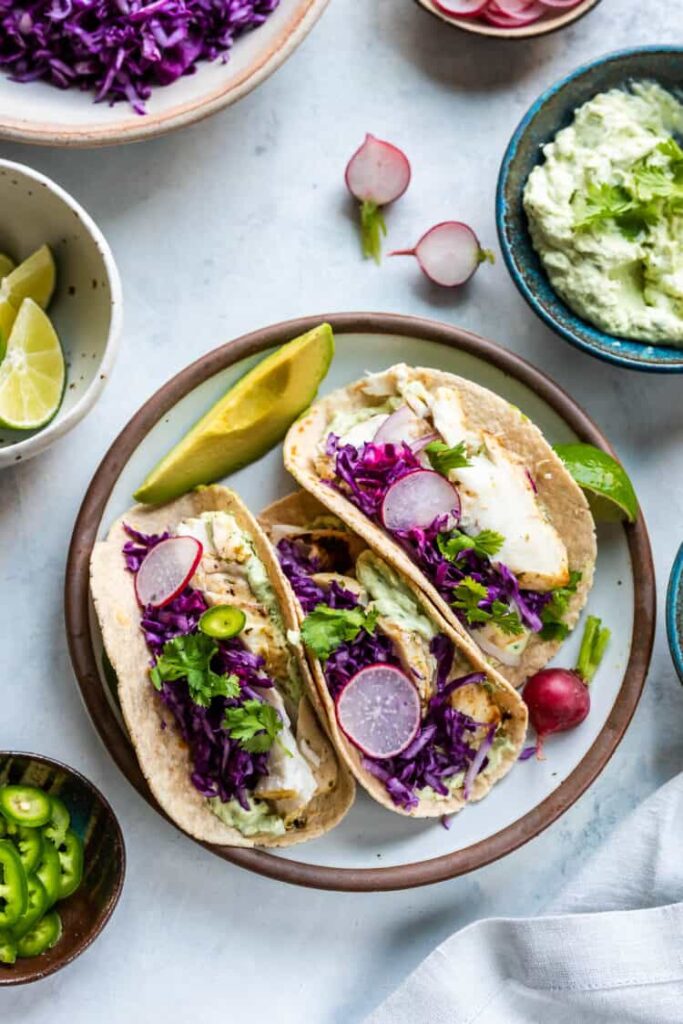
4) Halibut Tacos with Avocado Crema
For a fresh twist on fish tacos, try halibut tacos with avocado crema. Start by seasoning your halibut with taco seasoning, salt, and pepper. Heat a skillet over medium heat and add some avocado oil. Once the oil is hot, add the halibut. Cook the fish for about 4 minutes on each side, depending on thickness, until it’s cooked through.
While the halibut cooks, prepare the avocado crema. Mash the avocado in a bowl until it’s smooth. Mix in some yogurt, lime juice, salt, and pepper. For an extra kick, you can add diced jalapeño.
Warm your tortillas in a skillet or microwave. To assemble, spread a spoonful of avocado crema on each tortilla. Add the cooked halibut, then top with shredded cabbage and cilantro. You can also add other toppings like salsa or pickled onions if desired.
These tacos are quick, delicious, and perfect for a weeknight meal. The creamy avocado pairs wonderfully with the mild, flaky halibut. Enjoy your tasty and nutritious meal!
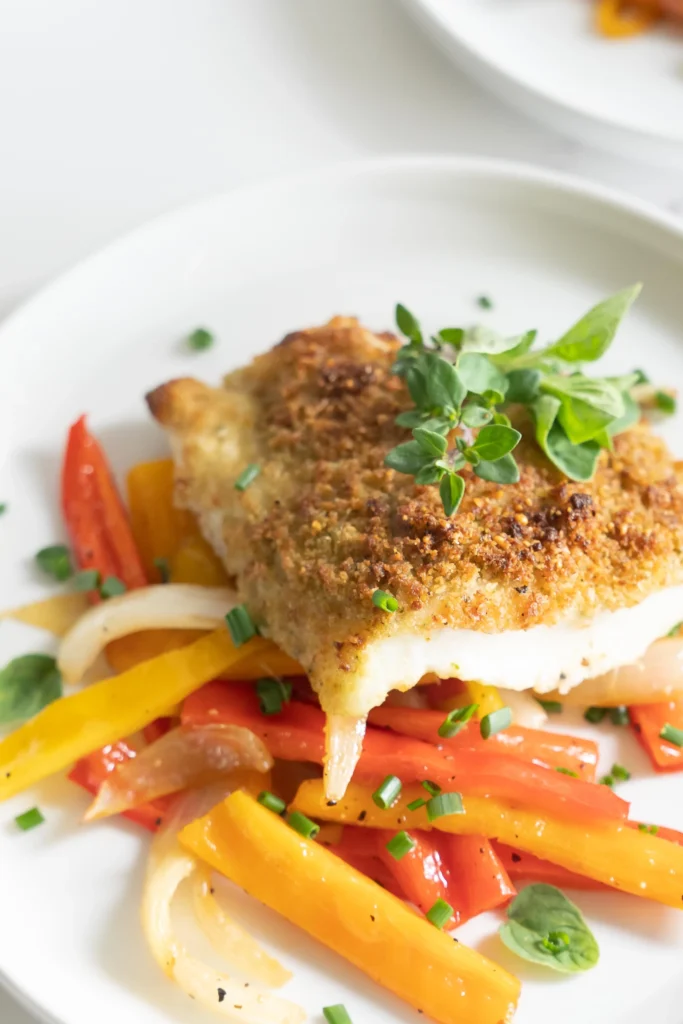
5) Baked Halibut with Parmesan Crust
To make baked halibut with a parmesan crust, start by preheating your oven to 400°F (200°C). Line a baking sheet with parchment paper or foil.
In a shallow bowl, mix together grated Parmesan cheese, minced garlic, salt, pepper, paprika, parsley, and lemon zest. This will be your crust mixture.
Brush halibut fillets lightly with olive oil. Then, dip each fillet into the parmesan mixture. Make sure both sides are evenly coated.
Place the coated fillets on the prepared baking sheet. For extra crispiness, you can set the baking sheet in the refrigerator for 20-30 minutes before baking.
Bake the halibut for 10-15 minutes or until the fish is opaque and flakes easily with a fork. Serve with lemon wedges and a sprinkle of fresh parsley for garnish.
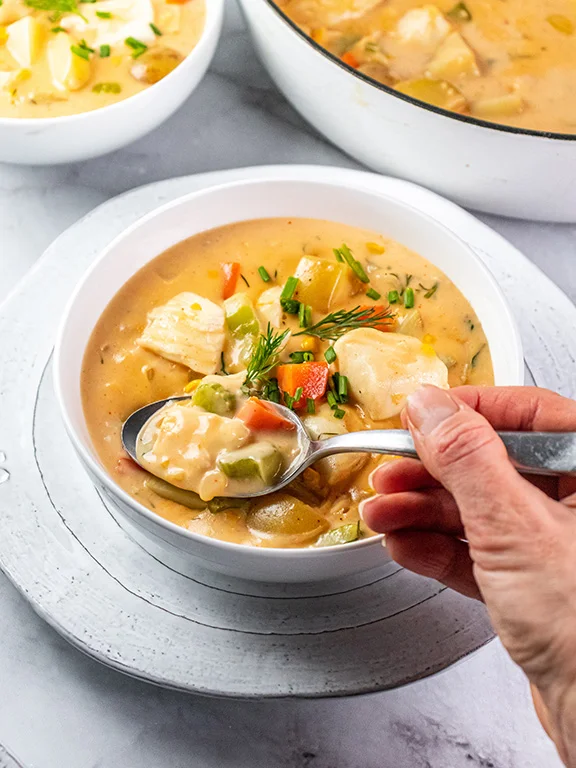
6) Halibut Chowder
Halibut chowder is a hearty and comforting dish for cold days. Start by melting butter in a large pot over medium heat. Add onions and cook until they turn translucent. Add diced potatoes and garlic, cooking until the potatoes soften a bit.
Pour in chicken stock, tomatoes, and carrots. Bring the mixture to a boil, then reduce the heat. This allows the flavors to meld together.
Add the cooked halibut along with herbs and spices. Continue simmering on low heat. Some recipes suggest adding flour to thicken the chowder and cream to make it rich and creamy.
Simmer until the potatoes and other vegetables are tender. Make sure not to overcook the halibut. Overcooking can make it dry and tough. The goal is to have tender chunks of fish in every bite.
For extra flavor, you can add corn, celery, and bay leaves. Serve the chowder hot, garnished with fresh chives or parsley. A crusty bread on the side makes a perfect companion for this dish.
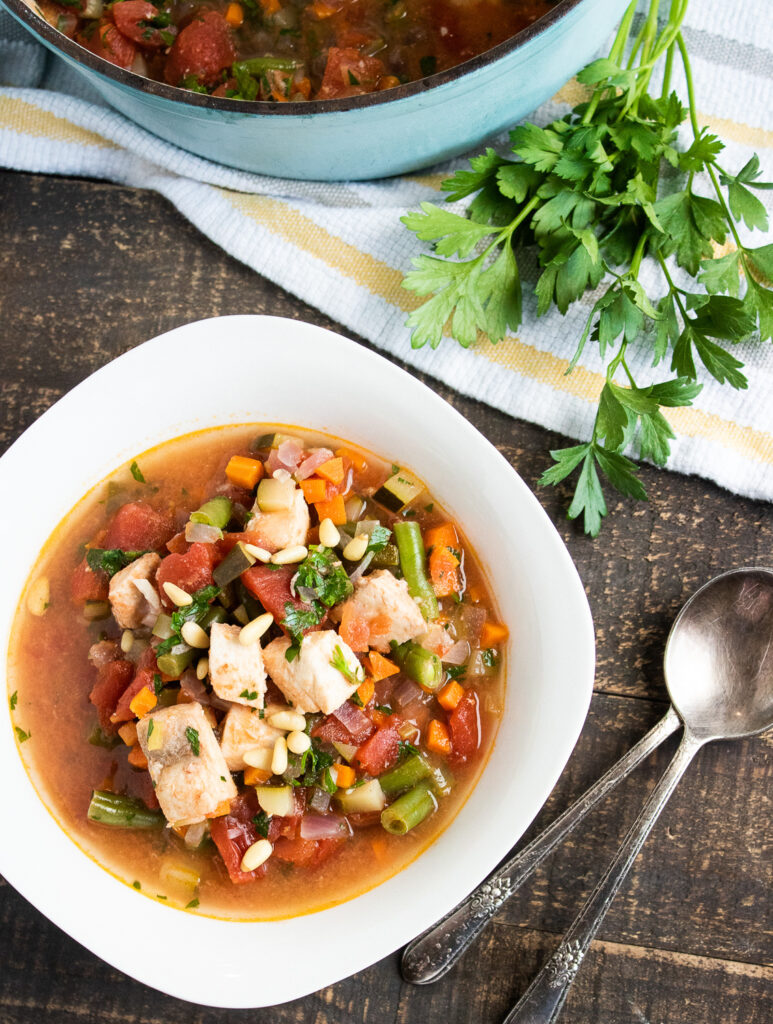
7) Halibut Stew with Vegetables
Halibut stew with vegetables is a hearty and nutritious meal. Start by heating some butter and olive oil in a large pan over medium heat. Add chopped green onions and cook them for about a minute. Then, add diced potatoes and stir them to coat with the butter and oil.
Next, pour in one cup of vegetable or fish broth. Add a pinch of salt and some thyme for flavor. Let it simmer for a few minutes until the potatoes start to soften. This helps the flavors blend well.
Now, it’s time to add the halibut. Cut the fish into large chunks and place them gently into the pan. You can also add other seasonal vegetables like carrots, celery, or green beans to the stew.
Cover the pan with a lid and let everything simmer on low heat for 20-25 minutes. Remember to stir occasionally so the stew doesn’t stick to the bottom. The fish should be tender and the vegetables cooked through.
Serve your halibut stew hot, garnished with fresh herbs if you like. This dish makes for a perfect comfort meal, especially on cooler days. Enjoy!

8) Cedar Plank Halibut
Cedar plank halibut is a delicious way to enjoy this fish. The cedar wood gives the halibut a smoky flavor.
Start by soaking a cedar plank in water for about 30 minutes. This helps prevent the wood from burning on the grill.
While the plank soaks, prepare your grill to medium-high heat and oil the grate lightly.
Mix together butter, lemon juice, herbes de Provence, dill, tarragon, paprika, and minced garlic in a small bowl.
Place your halibut steaks on the soaked cedar plank. Brush the butter mixture over the fish.
Season with salt and freshly cracked pepper to taste.
Put the plank with the halibut on the grill. Close the lid and cook for about 15-20 minutes, or until the fish reaches 145°F internally.
Serve the halibut directly on the cedar plank for an impressive presentation that enhances the flavor.
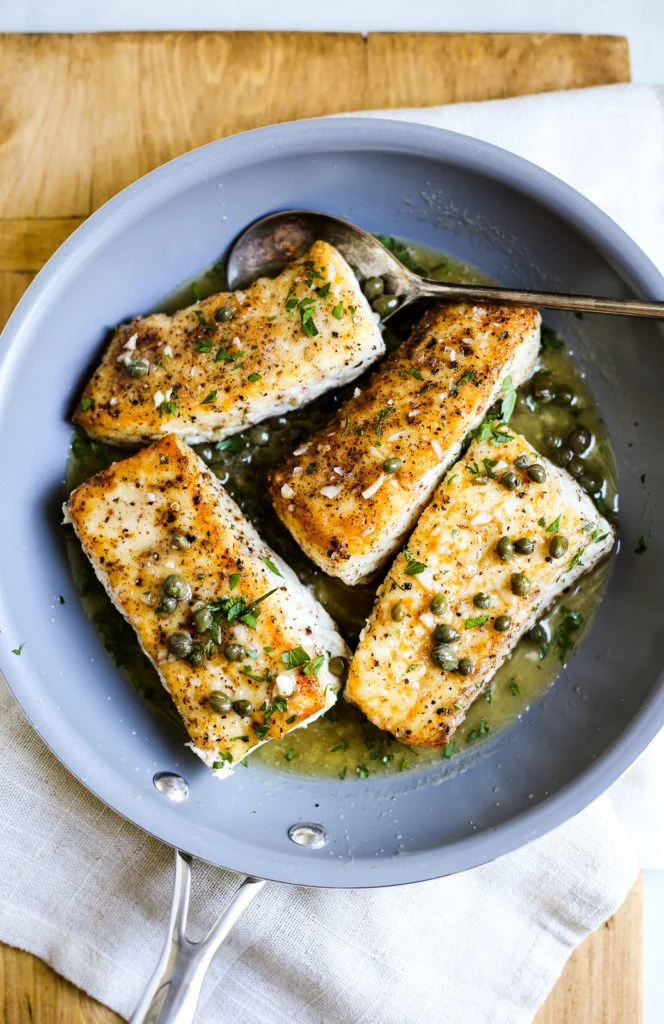
9) Halibut Piccata
Season your halibut filets with kosher salt and black pepper. Prepare a mix of almond flour and tapioca flour for dredging. Coat the fish, then shake off the excess.
Heat oil in a non-stick skillet over medium-high heat. Sear the fish, about one minute per side, until golden brown. Transfer fillets to a baking sheet and set aside.
In the same skillet, add olive oil and chopped garlic. Sauté for about a minute until fragrant. Add capers and cook until the sauce thickens slightly. Whisk in butter and season with salt and pepper.
Drizzle the sauce over the seared halibut fillets. Garnish with chopped parsley before serving.
Serve your Halibut Piccata with a side of vegetables or over a bed of rice for a lovely meal.
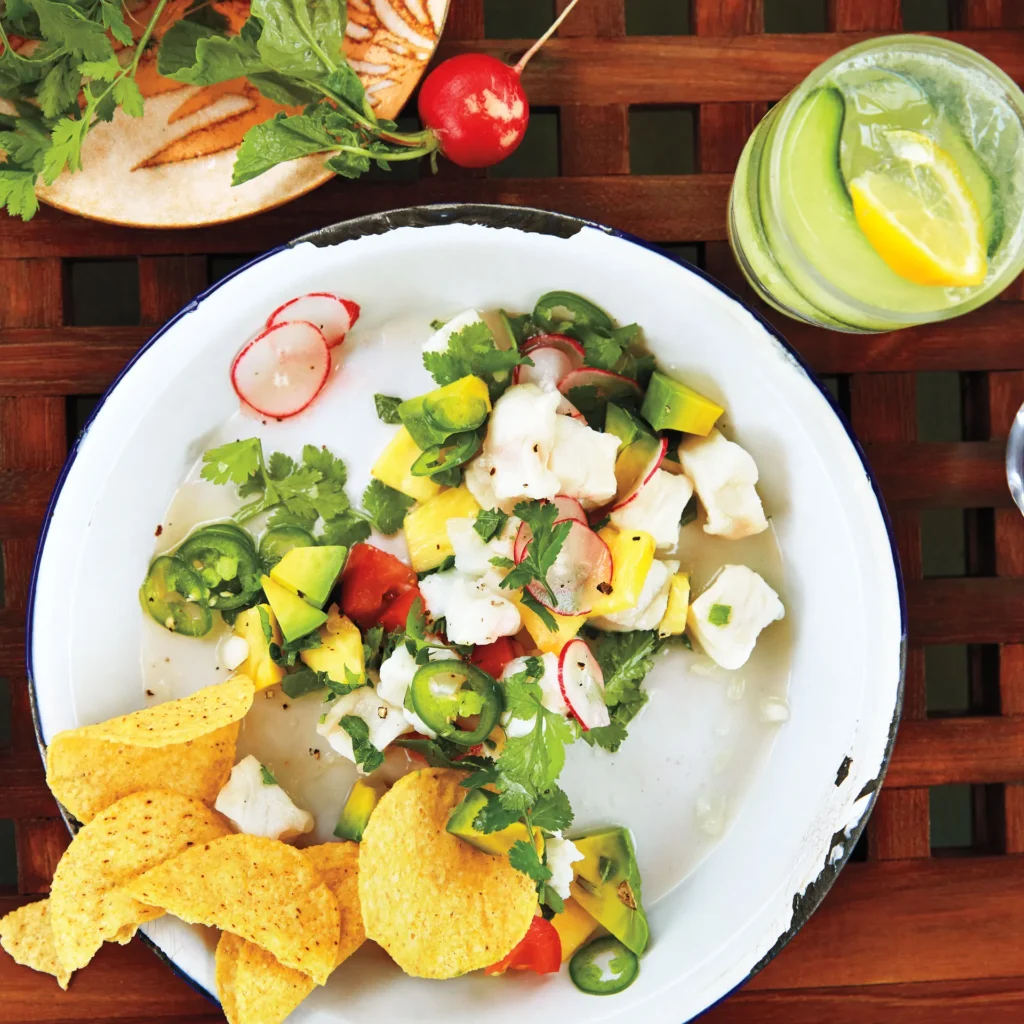
10) Halibut Ceviche
Halibut ceviche is a fresh and zesty dish that’s perfect for warm days. Start by cutting the halibut into 1/2-inch cubes. Place the cubes in a glass bowl.
Pour a mixture of lime and lemon juice over the fish. The acid from the juice will “cook” the fish, turning it opaque. Let it marinate in the fridge for at least 30 minutes to 4 hours.
After marinating, add diced tomatoes, avocado, red onion, jalapeno, and cilantro. Gently toss everything together. Season with sea salt and black pepper to taste.
Serve your halibut ceviche cold. You can enjoy it on its own or with some toasted bread or tortilla chips. This dish is light, tangy, and refreshing.
Health Benefits of Halibut
Eating halibut offers a variety of health benefits due to its rich nutritional profile and high omega-3 fatty acid content.
Nutritional Profile
Halibut is a nutrient-dense fish that provides many essential vitamins and minerals. A four-ounce serving of halibut contains up to 30 grams of high-quality protein, which is crucial for muscle repair and overall body function. Vitamins B6, B12, and niacin are abundant in halibut, helping support energy production and reduce fatigue.
In addition, this fish is low in fat, making it suitable for low-fat diets. Selenium, found in halibut, is an important antioxidant that protects your cells from damage. Magnesium in halibut supports muscle and nerve function. Including halibut in your diet ensures you get a good mix of these essential nutrients.
Omega-3 Fatty Acids
Halibut is an excellent source of omega-3 fatty acids, which are crucial for heart and brain health. Omega-3s help reduce inflammation and lower blood pressure, reducing the risk of heart disease. They also play an essential role in maintaining healthy cholesterol levels by lowering triglycerides.
These fatty acids support cognitive function, enhancing memory and protecting against age-related cognitive decline. A single serving of halibut provides about 1.1 grams of omega-3s, meeting the recommended intake for women and providing a substantial portion of the recommended intake for men. Regular consumption can significantly contribute to your overall health.
Cooking Tips for Halibut
To make the most out of your halibut dishes, it’s crucial to select the freshest fish and store it properly.
Selecting Fresh Halibut
When choosing fresh halibut, look for fillets or whole fish that have firm, translucent flesh. The color should be a bright, almost opalescent white. Avoid any pieces that look dry or have a dull appearance.
Smell is another important factor. Fresh halibut should have a mild, salty ocean scent. Fish that smells overly fishy or sour is likely past its prime. You should also check the skin if it’s still on; it should be shiny and free from any brown or discolored spots.
Lastly, purchasing from a reputable source ensures high quality. A local fish market or a trusted supermarket is usually your best bet for finding fresh halibut.
Proper Storage Methods
Proper storage keeps your halibut fresh and ensures it remains safe to eat. After purchasing, place the fish in the coldest part of your refrigerator, ideally at 32°F (0°C). Use a container with a lid or wrap it tightly in plastic wrap to prevent any exposure to air.
If you need to store it for more than a day or two, freezing is a good option. To freeze halibut, wrap it in freezer paper or aluminum foil, then place it in a zip-lock bag. Label the bag with the date and try to use it within three months for the best quality.
Avoid thawing halibut at room temperature. Instead, defrost it in the refrigerator overnight or under cold running water if you need it quickly.
Common Cooking Techniques
There are various ways to cook halibut, but some of the most popular methods are grilling, baking, and pan-searing. Each technique offers a unique flavor and texture to the fish.
Grilling
Grilling halibut brings out a smoky flavor and gives it a delicious char. Start by preheating your grill to medium-high heat. Lightly oil the grill grates to prevent sticking.
Season the halibut fillets with salt, pepper, and any other desired spices. You can also marinate the fish for added flavor. Place the seasoned fillets on the grill and cook for about 4-5 minutes on each side. The fish should be opaque and flake easily with a fork when done.
Use a spatula to carefully flip the fish halfway through cooking. Serve immediately with a squeeze of fresh lemon juice for added brightness.
Baking
Baking halibut is a simple and healthy way to prepare this fish. Preheat your oven to 400°F. Lightly grease a baking dish or line it with parchment paper.
Place the halibut fillets in the baking dish. Season them with salt, pepper, and your choice of herbs, such as dill or parsley. For extra flavor, you can add slices of lemon or a drizzle of olive oil.
Bake the fish for 10-15 minutes, or until it is opaque and flakes easily with a fork. Avoid overcooking, as this can cause the fish to become dry. Baking is a versatile method that can be paired with vegetables for a complete meal.
Pan-Seared
Pan-searing halibut creates a crispy, golden exterior while keeping the inside moist and tender. Start by heating a non-stick skillet over medium-high heat. Add a tablespoon of oil, such as olive oil or vegetable oil.
Pat the halibut fillets dry with paper towels, then season them with salt and pepper. Once the skillet is hot, place the fillets in the pan, skin side up if they have skin.
Cook for about 4-5 minutes on the first side, without moving the fish. Flip the fillets carefully using a spatula and cook for another 3-4 minutes. The fish should be opaque and flake easily. Serve with a sauce like a lemon butter or herb butter for added richness.








